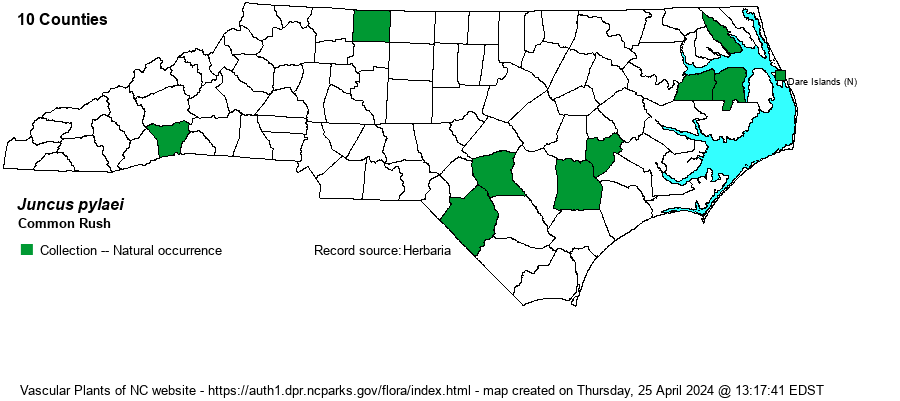| Section 5 » Family Juncaceae |
Show/Hide Synonym
| taxonName | relationship | relatedTaxonName | relatedTaxonRefText | relComments |
|---|
|
|
|
|
| Juncus pylaei | > | Juncus effusus var. costulatus | Fernald (1950) | | | Juncus pylaei | > | Juncus effusus var. pylaei | Fernald (1950) | | | Juncus pylaei | < | Juncus effusus | Flora of North America (1993b, 1997, 2000, 2002a, 2002b, 2003a, 2004b, 2005, 2006a, 2006b, 2006c, 2007a, 2009, 2010) | | | Juncus pylaei | < | Juncus effusus | Godfrey and Wooten (1979, 1981) | | | Juncus pylaei | < | Juncus effusus | Radford, Ahles, and Bell (1968) | | | Juncus pylaei | < | Juncus effusus | Small (1933, 1938) | | | Juncus pylaei | < | Juncus effusus | Flora of Virginia | | | Juncus pylaei | < | Juncus effusus | Wofford (1989) | | | Juncus pylaei | < | Juncus effusus var. solutus | Gleason (1952) | | | Juncus pylaei | = | Juncus effusus ssp. pylaei ined | | | | Juncus pylaei | = | Juncus effusus var. pylaei | | | | Source: Weakley's Flora |
|
| Author | Laharpe | |
| Distribution | Mostly Coastal Plain, but also Stokes and Henderson counties. To date, only MICH and NCU herbaria have specimens labeled as Juncus pylaei. More records are expected to come to light as other herbaria annotate their specimens from J. "effusus". Weakley (2018) says "overlooked and probably more widespread and common than shown [on his range map]". Though the website map below is very similar to that shown on the BONAP atlas map, it can be assumed that this species is more frequent across the state, as Weakley's (2018) map shows "uncommon" for all three provinces in NC.
Throughout eastern N.A., south to SC. | |
| Abundance | Apparently uncommon; need more data. As this is a rather Northern species, ranging south only to SC, it is highly unlikely that 80-90% of the counties of occurrence in NC would be in the Coastal Plain, as seen on the incomplete map. For now, the website editors chose to go with a State Rank of S3?, based mostly on Weakley's (2018) map showing "uncommon" in each of the state's 3 provinces. | |
| Habitat | Wet to moist marshes, meadows, impoundments, beaver ponds, river shores, oxbow ponds, interdune ponds, roadside ditches. |
| Phenology | Flowering and fruiting June-September. | |
| Identification | Common Rush grows 2-4 feet tall and form many-stemmed tussocks from short, scaly rhizomes. The plant appears leafless, although bladeless leaf sheaths are found at stem bases. There is a single branched inflorescence, appearing to grow from the side of the stem; but in fact it is terminal and overtopped by a long, sharp-pointed bract which looks just like the continuation of the stem. Leathery Rush (J. coriaceus) is quite similar, but stems are not as soft and the capsule is more rounded in shape. The very common Soft Rush (J. effusus) is virtually identical, but stems have 25-30 striations (shallow grooves) below the inflorescence (vs. 10-20) and tepals are 1.9-2.8 mm long (vs. 2.7 mm or more). | |
| Taxonomic Comments | The divisions within J. effusus are not yet fully worked out. Though Weakley (2018) splits out J. pylaei as a full species, most references do not recognize this taxon at all, or at most only as a variety.
NOTE on Juncus: These "grasslike" or "sedgelike" plants occur in most habitats, especially where moist or wet. They can immediately be told from grasses and sedges by the presence of 6 tepals (petal-like) that surround the fruit. These tepals can be thought of as analogous to sepals and petals of, say, lilies or trilliums. Most species have brown, chestnut, or reddish tepals and dark brown fruits. The flowers occur in few- to many-flowered heads. Leaves are nearly all basal and round in cross-section. Stems are unbranched, except for the inflorescence. Fruits are termed capsules and contain many tiny seeds. | |
| Other Common Name(s) | Pylaei's Rush, Pylaei's Soft Rush | |
| State Rank | [S3?] | |
| Global Rank | G5? | |
| State Status | | |
| US Status | | |
| USACE-agcp | OBL link |
| USACE-emp | OBL link |

